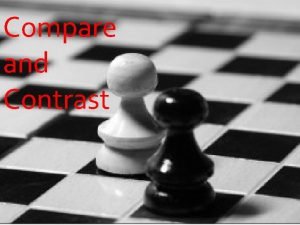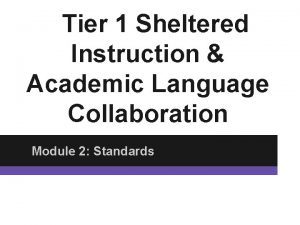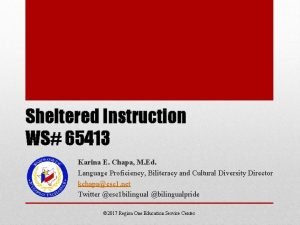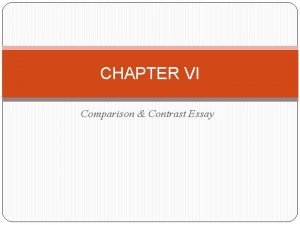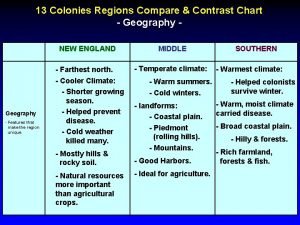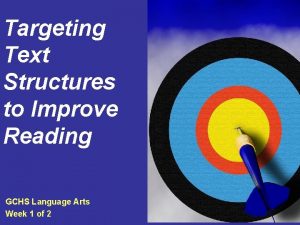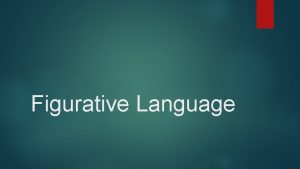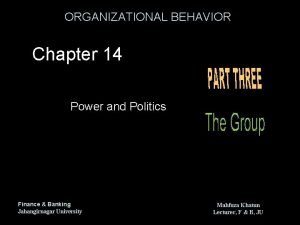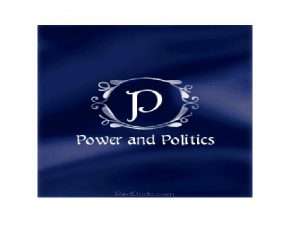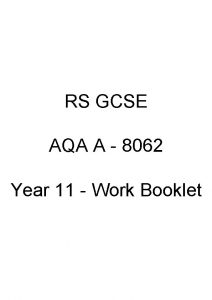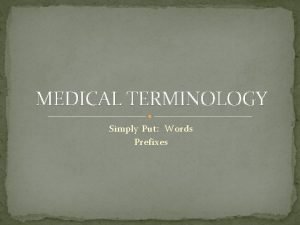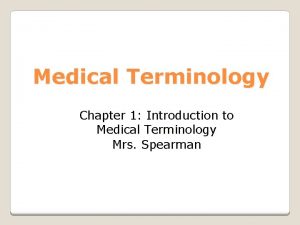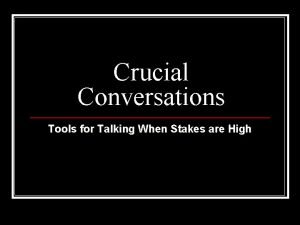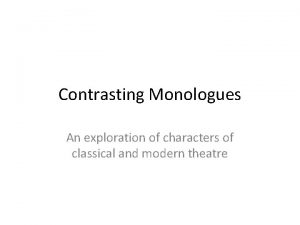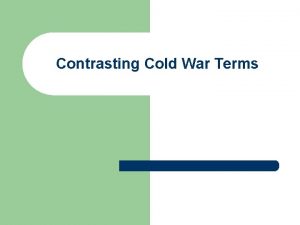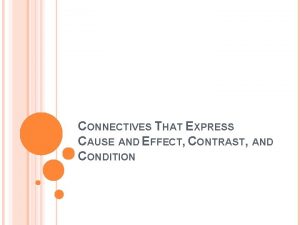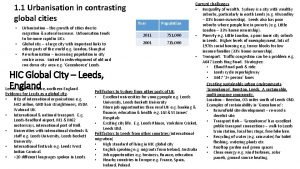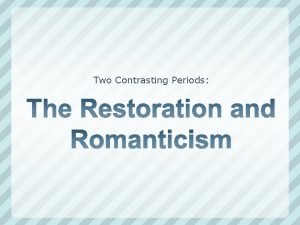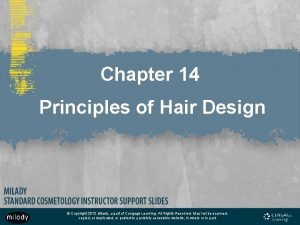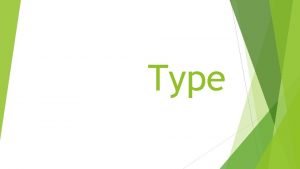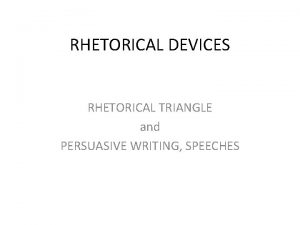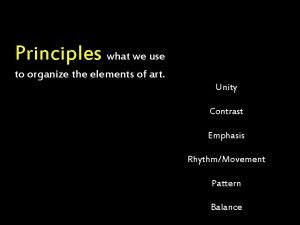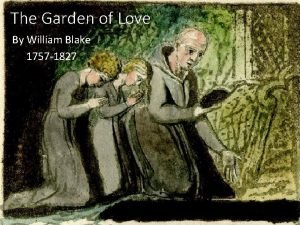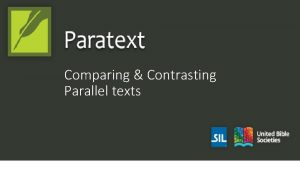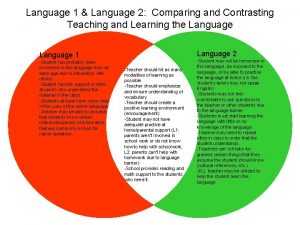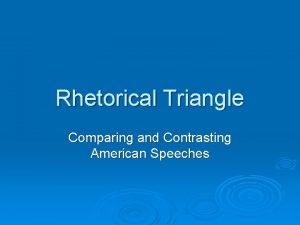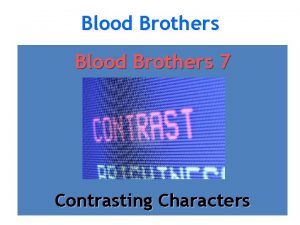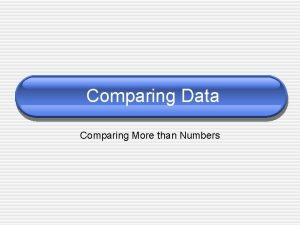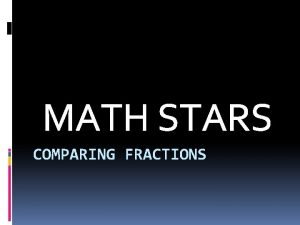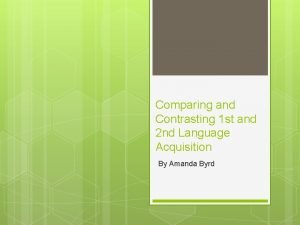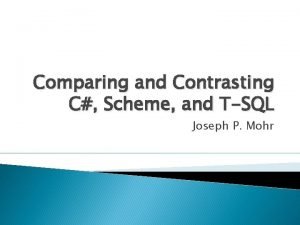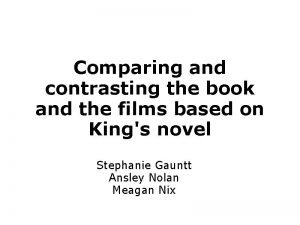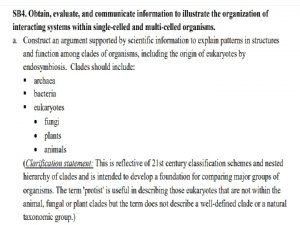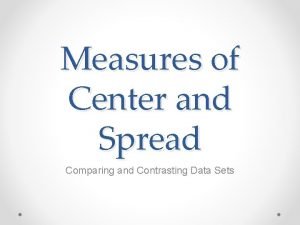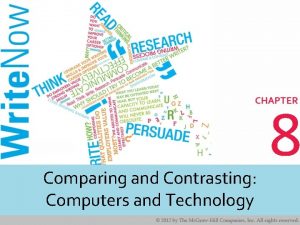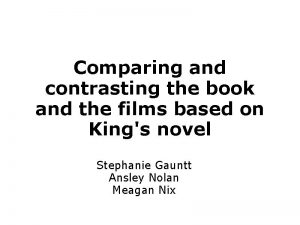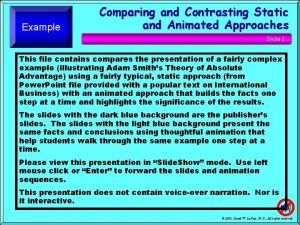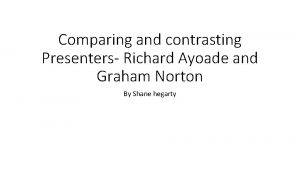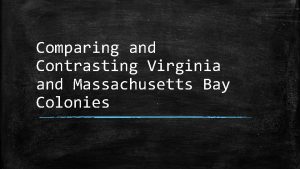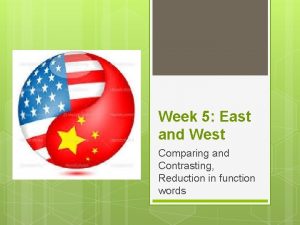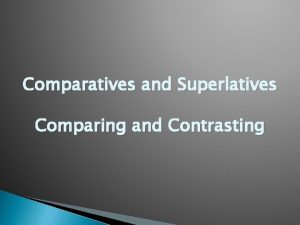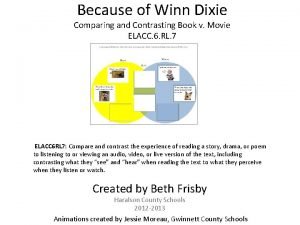Comparing and Contrasting Language Education in American and


![The limit of [one’s] language mean the limits of [one’s] world” —Ludwig Wittgenstein The limit of [one’s] language mean the limits of [one’s] world” —Ludwig Wittgenstein](https://slidetodoc.com/presentation_image_h2/52782a212291350392783ba753e65ebb/image-3.jpg)























- Slides: 26

Comparing and Contrasting Language Education in American and Polish Schools Monika Czopek Elementary Education Major Polish Studies, Bilingual and Special Education Minor Loyola University – 2021

Monika Czopek This presentation represents my professional and personal growth throughout my academic career, not only as a Student Teacher Candidate but also as a Polish -American Citizen. I was born in Poland came to the United States at a young age. This being the case, I attended Polish Saturday School while in American School during the week. This presentation consists of detailed research that expresses the importance of bilingual and dual language education. Students who speak a first language other than English should be given the opportunity to develop both languages, rather than allowing English to dominate. Having experienced what most bilingual students do now, I hope to bring awareness to the significance of bilingual education and make a change of what is valued in our current from of Education.
![The limit of ones language mean the limits of ones world Ludwig Wittgenstein The limit of [one’s] language mean the limits of [one’s] world” —Ludwig Wittgenstein](https://slidetodoc.com/presentation_image_h2/52782a212291350392783ba753e65ebb/image-3.jpg)
The limit of [one’s] language mean the limits of [one’s] world” —Ludwig Wittgenstein

01 02 POLISH LANGUAGE POLISH SATURDAY SCHOOLS The main focus of this study, and is taught as a foreign language as well as a heritage language Offer children of Polish descent a lot of help in regard to the development of knowledge in the Polish language and history. 03 04 ANALYSIS OF DATA The importance of language and culture in education is proven CONCLUSION It is important to continue to work towards implementing dual language programs that support a variety of different languages.

POLISH 01. LANGUAGE The Polish language as a foreign and heritage language.

Polish as a Foreign Language Taught this way most often in. . . ● Universities ● Some, not all, High Schools Learning a foreign language for adults opens many doors in terms of job opportunities and interests about another culture outside of their own. People choose to learn a foreign language for their own benefit, as they see the advantages of being able to communicate with a variety of different people.

Polish, like many other languages, is not easy to learn… Grammar Pronunciation When it comes to writing in Polish, there are many rules that you must follow and specific letter combinations that you must use. Using declensions in Polish depends on the way you use a specific word in a sentence. Additionally, there is some freedom when it comes to building sentences in Polish, where no one specific order is necessary. There are many different letter and word combinations that make it very difficult to pronounce. For many, such words as Szczęście or Żółć could be very hard to pronounce because of the different combinations of consonants that many are not used to seeing in words.

Polish as a Heritage Language is often learned at home Many Polish families attempt to maintain the language and the culture at home; however, it is never fully developed because of the social environment that is dominated by the English language. The Polish language is not taught in American schools, and that is why Polish Saturday schools were established. Students must be able to develop their first languages as much as they should develop their acquired language, English.

Polish Saturday Schools. 02

POLISH SATURDAY SCHOOLS HISTORY AND PURPOSE This is where the Polish Language was taught as a heritage language Schools emerged along with the emergence of churches, as Poles have and continue to identify themselves strongly based on their Catholic religion alongside their national identity These schools were crucial in trying to prevent Polish students from losing knowledge about their traditions and culture Polish Saturday Schools were amongst the strongest ways that Poles were able to maintain their children’s Polish identity through education after immigrating to the United States They help Poles all over the world to be able to safeguard their national identity and be able to identify themselves as true Poles

Polish Saturday Schools are Essential They offer children of Polish descent much assistance in the development of knowledge in the Polish language and history compared to what students were previously offered by American Schools alone

Data 03. Analysis The Polish language as a foreign and heritage language.

Polish Schools in America Polish School offers the students 3. 5 hours of instruction in the Polish language about Polish literature, orthography, grammar, culture, history, geography, and religion. There were a total 35 responses from students attending kindergarten through third grade at the Henryk Sieńkiewicz Polish School. The population that attends Polish Saturday schools makes up only 0. 3% of the whole Polish population in the United States only appr. 26, 000 students attend out of the population of over 9 million Poles.

Data Analysis FIRST LANGUAGE 8% 3% POLISH ENGLISH 6% PARENT BACKGROUND BOTH 3% OTHER 3% POLISH BOTH 83% BOTH POLISH 94% OTHER: SP ANISH Polish immigrants felt pressured to pass their language and culture on to their children as it was something that was disappearing with the minimal offerings of Polish in bilingual programs at American schools. Based on this data, a majority of the parents who identify as Poles introduced Polish to the child first, before introducing the English language, as a way of immersing their children in their ancestral culture. Polish immigrants have created expectations for themselves and their children that they must fulfill in order to maintain the Polish identity.

Which language is the most difficult to learn? 17% POLISH ENGLISH 23% 60% SAME LANGUAGE PREFERENCES Students experienced the most difficulty with learning Polish. One would think that a child would experience more difficulty learning a foreign language rather than the very language they grew up speaking. Parents insist that their children speak their heritage language, though it may not be the one used most frequently by the child themselves.

LANGUAGE MOST OFTEN USED AND HEARD HOME LANGUAGE VS. SOCIAL LANGUAGE 30 25 25 20 20 24 15 20 14 15 10 BOOKS VS SCREEN TIME 8 13 14 12 9 10 9 6 7 3 5 1 0 5 0 POLISH ENGLISH HOME LANGUAGE BOTH OTHER SOCIAL LANGUAGE Based on the data, a majority of the student population uses the Polish language at home. On the other hand, most children use the English language or both during social interaction, outside of their home and amongst their friends. This shows that regardless of how hard parents may try to implement the Polish language and culture in their homes, if it is not as apparent and used socially or during the children’s daily studies, then there is a greater chance of their children losing the language in the process of acquiring English. BOOKS POLISH SCREEN TIME ENGLISH BOTH There are more children who read books in Polish than in English, although English trails right behind. This once again reveals the expectations that parents may have for their children in needing to learn the Polish language and acquiring the basic skills of reading, writing, listening, and speaking in the language. However, when we analyze the number of children that watch television in Polish rather than in English, we observe that less than half of the student population does so. This could be a direct indication that the English language is preferred by a majority of the students, as that is the language that they entertain themselves in.

Children are only exposed to the literacy aspect of Polish during Polish Saturday Schools, which is why it is difficult to maintain the language.

There are MANY ways to combat this language barrier BILINGUAL PROGRAMS

BILINGUAL PROGRAMS Some bilingual education models remain subtractive in nature where the development of the second language is done at the expense of the native language (Brisk, 2005, p. 46). There are other bilingual programs, such as the dual language program, that focus on developing the native language while acquiring the English language, thus being additive in nature. The English language is taught much differently in comparison to the Polish language; however, developing both languages simultaneously proves to be the most effective. There are currently only 15 schools in the Chicago area that offer Spanish dual language education programs, thus, it is necessary to work towards constructing dual language programs that offer more languages, such as Polish.

BENEFITS OF PAIRED BILINGUAL PROGRAMS Based on the study conducted by Pawlicka, it has been proven that students receiving bilingual education, in both English and Polish, received higher results in Polish word reading than their peers receiving monolingual Polish education (Pawlicka, Lipowska, & Jurek, 2018, p. 28) In the long term, pairedbilingual training proved to be the most beneficial in terms of reading efficiency in the first language.

PROCESS OF LEARNING VOCABULARY ORTHOGRAPHY SYLLABLES Polish is a “morphophonemic, inflectional and consonantal language” (Pawlicka, Lipowska, & Jurek, 2018, p. 29) meaning that it is predominated mainly by words with many syllables, thus syllable structures are very important to learn, often the first things to be covered Syllable structures are important as they contribute to phonological segmentation which students use to break down words based on their individual sounds and syllables, improving their fluency the quicker they are able to recognize them when reading. In terms of reading, Polish orthography is transparent, however, it is very critical to pay attention to it in terms of writing and spelling. The reason for this is because in the Polish language there are multiple rules of when to use letters or consonant clusters that may sound similar, such as rz and ż or ó and u. Such letters and consonant clusters sound identical when read in a word, however they cannot be used interchangeably. The children first begin to develop phonemic awareness, relying highly on letter-sound correspondences, similar to the English language. Phonological awareness is important as it builds phonemic and syllable awareness that is necessary to have when learning the Polish language Vocabulary is not a huge focus for the children until they start first or second grade, which is when they are asked to learn the meaning of words and understand their importance in sentences. In some American schools this is done through word study, where students practice different words for their level, building their phonological awareness as well as their vocabulary. .

IMPORTANCE OF BILINGUAL EDUCATION Although, since the student When English Language Learners population of this study is given more support in learn a new word, they begin by learning the English language learning its meaning and how to pronounce it, such as is done by by attending American school five days a week in students in Polish schools. Having some knowledge of identifying wordscomparison to Polish school which is only one day a in the native languages supports learning in the English language, week, the students’ English phonemic awareness and since children already have the phonemic awareness developed in knowledge becomes more their first language, making learning natural to the child than in their first language. English much easier for them. Children should not have to separate “Bilingual education has their education between the potential of being a transformativelanguages, instead they should be school practice, able to educate allgiven the opportunity to construct children in ways that stimulate meaning between them. For and expand their intellect and example, there are many cognates imagination, as they gain ways of between the English and Polish expression and access different language. Students need to learn to ways of being in the world” search for cross-linguistic (Garcia, 2008, p. 48) which is similarities which greatly supports crucial in terms of how fast their ability to learn a new language students learn when educated in if they are able to identify the both languages. connections to their first language.

CODE SWITCHING VS. TRANSLANGUAGING • The concept of code-switching is something that many bilinguals do in both American and Polish schools. • “Code-switching is defined as the juxtaposition within the same speech exchange of passages of speech belonging to two different grammatical systems or subsystems” (Garcia, 2008, p. 121). • This means that bilingual individuals are able to use both languages, switching them out throughout a sentence without messing up the meaning of the sentence. • Another way of code-switching could be done in the beginning or the ending of the sentence while still keeping the meaning of the whole sentence. This occurs spontaneously among bilingual speakers in Polish schools as well as American schools in communication with others who share their languages, including the teacher. • The use of code-switching should be encouraged in the classroom, as teachers could use the language students have built strong foundations in and work from that point in developing the child’s skills in a second, third, or even a fourth language. • This process and ability is of second nature to bilinguals, as in American schools, there are many children who will speak amongst themselves in their first language and will naturally switch to English without thinking twice about it • Translanguaging is the process whereby multilingual speakers use their • • languages, such as Polish and English, as a combined communication system. “Translanguagings are multiple practices in which bilinguals engage in order to make sense of their bilingual worlds” (Garcia, 2008, p. 112), and it goes beyond code-switching, as it is used to include and facilitate communication with others while constructing deeper understandings of both worlds of language. Bilinguals have more choices to make when speaking because their language repertoires have more language features which involve different sounds, words, verbs, adjectives, syntactic rules, and so on. It is truly important to combine the education of different languages so that they could be developed simultaneously, as students would be able to recognize cross-linguistic connections in order to create a better understanding of what they learn. Since there are no developed Polish dual language programs in Chicago, it is critical for parents to be able to work with their children in developing both languages by connecting Polish to their English education that they receive on a daily basis so that the children do not lose their Polish language by only receiving it academically on the weekends.

CONCLUSION • This study has proven that cultural and linguistic expectations are still apparent today within Polish families who put forth the effort in order for their descendants to maintain the Polish language and national identity. • The language most commonly used in society is also English, becoming a universal and primary language that people choose to develop and learn, thus causing the children’s Polish language to be undermined. • Despite the challenges that Poles may face today in regard to maintaining their first language, it is critical to continue learning and developing, as the more languages that people know, the greater the opportunity for them to learn about the world and observe it from a different perspective. . Bilingual students are offered more support now than ever before in American schools, nonetheless, it is important to continue to work towards implementing dual language programs that support a variety of different languages, opening up many opportunities that will provide diverse students with new knowledge about the world.

THANKS! Does anyone have any questions?

RESOURCES USED IN THE STUDY Brisk, M. (2005). Bilingual education from compensatory to quality schooling. Hillsdale: Lawrence Erlbaum. Garcia, O. (2008). Bilingual Education in the 21 st Century: A Global Perspective. s. l. : John Wiley and Sons Ltd. Garcia, O. , Ibarra, Johnson, S. , & Seltzer, K. (2017). The Translanguaging Classroom: Leveraging student bilingualism for learning. Caslon: Philadelphia, PA. Jaumont, F. (2017). The bilingual revolution: the future of education is in two languages. New York, NY: TBR Books. Otwinowska-Kasztelanic, A. (2011). Awareness of Cognate Vocabulary and Vocabulary Learning Strategies of Polish Multilingual and Bilingual Advanced Learners of English. In: J. Arabski and A. Wojtaszek (eds. ) Individual Learner Differences in SLA (pp. 110 -126). Bristol: Multilingual Matters. Palmer, D. K. , & Martinez, R. A. (2016). Developing Biliteracy: What Do Teachers Really Need to Know about Language? Language Arts, 93(5), 379– 385. Pawlicka, P. , Lipowska, M. , & Jurek, P. (2018). Bilingual advantage? Literacy and phonological awareness in Polish-speaking early elementary school children learning English simultaneously. Acta Neuropsychologica, 16(1), 27– 46. doi: 10. 5604/01. 3001. 0011. 7046 Potowski, K. (2010). Language diversity in the USA. New York: Cambridge University Press. Proops, I. (2000). Logic and language in Wittgensteins Tractatus logico- philosophicus. New York: Garland. Tompkins, G. E. (2017). Literacy for the 21 st century: a balanced approach (7 th ed. ). Boston: Pearson. US Census Bureau. (2018, September 27). Polish American Heritage Month: October 2018. Retrieved November 21, 2019, from https: //www. census. gov/newsroom/stories/2018/polish-american. html.
 Compare and contrast hinduism and buddhism
Compare and contrast hinduism and buddhism Compare and contrast defintion
Compare and contrast defintion Karina is writing a paragraph comparing and contrasting
Karina is writing a paragraph comparing and contrasting Karina is writing a paragraph comparing and contrasting
Karina is writing a paragraph comparing and contrasting Compare contrast signal words
Compare contrast signal words New england middle and southern colonies comparison chart
New england middle and southern colonies comparison chart Comparing and contrasting
Comparing and contrasting A simile compares two things
A simile compares two things What are the 5 elements of hair design
What are the 5 elements of hair design Illegitimate political behaviour
Illegitimate political behaviour Impression definition
Impression definition Unit 5 international business m2
Unit 5 international business m2 Eid ul-fitr quotes from qur'an gcse
Eid ul-fitr quotes from qur'an gcse Hepa prefix
Hepa prefix The word root athr means ________.
The word root athr means ________. Talk tentatively
Talk tentatively What is a contrasting monologue
What is a contrasting monologue Contrasting cold war terms
Contrasting cold war terms The cold weather, we stayed home
The cold weather, we stayed home Contrasting acquisition
Contrasting acquisition Urbanisation in contrasting global cities
Urbanisation in contrasting global cities Contrasting period
Contrasting period Hair design
Hair design An easier way to choose contrasting structures is to pick
An easier way to choose contrasting structures is to pick Logos definition literature
Logos definition literature Opposing size shapes contrasting colors
Opposing size shapes contrasting colors Garden of love poem analysis
Garden of love poem analysis

